Today is...
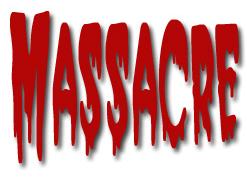 The
Ponce Massacre of 1937
The
Ponce Massacre of 1937
...was a police slaughtering over a peaceful civilian march, taking place in 21
March 1937 at 3:15 pm, in Palm Sunday, Ponce, Puerto Rico, that killed 19 people
and wounded over 200 others. It is the largest massacre in Puerto Rican history.
The march had been organized by the Puerto Rican Nationalist Party to
commemorate the abolition of slavery in Puerto Rico by the governing Spanish
National Assembly in 1873. The march was also protesting the U.S. government's
imprisonment of the party's leader, Pedro Albizu Campos, on alleged sedition
charges.
An investigation by the Hays Commission put the blame squarely on the
U.S.-appointed Governor of Puerto Rico, Blanton Winship. Further criticism by
members of the U.S. Congress led President Franklin D. Roosevelt to remove
Winship in 1939 as governor. Governor Winship was never prosecuted for the
massacre. No one under his chain of command - including the police who took part
in the event, and admitted to the mass shooting - was ever prosecuted or
reprimanded.
Several days before the scheduled Palm Sunday march, the Nationalists had
received legal permits for a peaceful protest from José Tormos Diego, the mayor
of Ponce. According to a 1926 Puerto Rico Supreme Court ruling, government
permits were not necessary for the use of plazas, parks or streets for meetings
or parades. However, as a courtesy to the Ponce municipal government, the
Nationalists requested the permit nevertheless.

Carlos Torres Morales, a photo journalist for the newspaper El Imparcial
was covering the march and took this photograph when the shooting began.
However, upon learning about the march, Winship, ordered the new Insular Police Chief, Colonel
Enrique de Orbeta, to contact Mayor Tormos and have him cancel the parade
permit. He also ordered Orbeta to increase the police force in the southern
city, and to stop, "by all means necessary", any demonstration conducted by the
nationalists in Ponce. Without notice to the organizers, or any opportunity to
appeal, or any time to arrange an alternate venue, the permits were abruptly
withdrawn, just before the protest was scheduled to begin.
Following Winship's orders, Colonel Orbeta went to Ponce where he
concentrated police units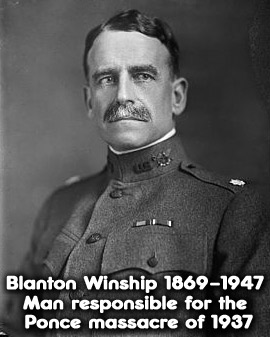 from across the island sporting "the latest riot
control equipment", among which he also included the machine gunners in the
island. For many days, Winship had planned to crush the activities of the
Nationalists and their leader, Pedro Albizu Campos, and ordered the shootings.
from across the island sporting "the latest riot
control equipment", among which he also included the machine gunners in the
island. For many days, Winship had planned to crush the activities of the
Nationalists and their leader, Pedro Albizu Campos, and ordered the shootings.
Juana Diaz, Police Chief Guillermo Soldevilla, with 14 policemen, took a
position in front of the marchers. Chief Perez Segarra and Sgt. Rafael Molina,
commanding nine policemen armed with Thompson submachine gunsand tear gas bombs,
stood in the back. Chief of Police Antonio Bernardi, heading 11 policemen armed
with machine guns, stood in the east; and another group of 12 police, armed with
rifles, was placed in the west. According to some reports, police numbered "over
200 heavily armed" guards.
As La Borinqueña, Puerto Rico's national song, was being played, the Ponce
branch of the Cadetes de la República under the command of Tomás López de
Victoria and the rest of the demonstrators began to march. The Insular Police
then started firing on the marchers - killing 17 unarmed civilians, two
policemen, and wounding some 235 civilians, including women and children.
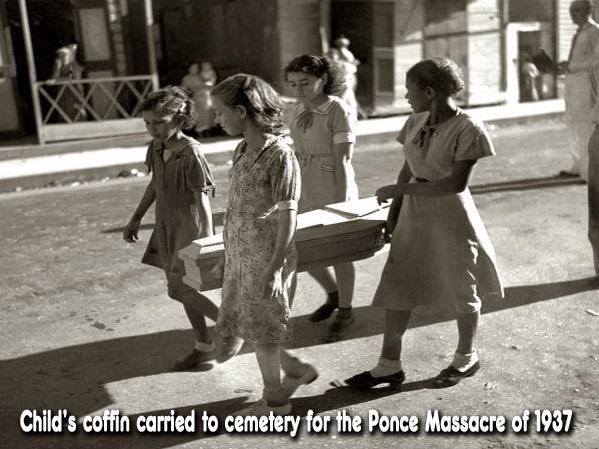
A seven-year-old girl was also killed by a bullet. Police firing went on for
over 15 minutes.
The dead included 17 men, one woman, and the seven-year-old
girl. Some of the dead were demonstrators, while others were simply passers-by.
As of 2009, only two survivors were still known to be alive, Fernando Velez and
his sister Beatriz Velez, nephew and niece of patriots Emeli Velez and Erasmo
Vando.
The flag-bearer of the Cadets of the Republic was shot and killed during the
massacre. A young girl by the name of Carmen Fernández proceeded to take the
flag, but was shot and gravely injured. A
young Nationalist cadet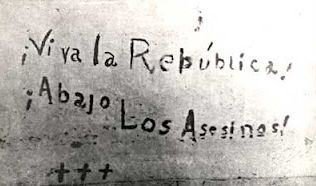 by the name of Bolívar Márquez, dragged himself to the
wall of Santo Asilo de Damas and wrote with his blood the following message
before dying:
by the name of Bolívar Márquez, dragged himself to the
wall of Santo Asilo de Damas and wrote with his blood the following message
before dying:
"¡Viva la República, Abajo los asesinos!”
(“Long live the Republic, Down with the Murderers!”)
Many were chased by the police and shot or clubbed at the entrance of their
houses as they tried to escape. Others were taken from their hiding places and
killed. Leopold Tormes, a member of the Puerto Rico legislature, told reporters
how a policeman murdered a nationalist with his bare hands. Dr. Jose N. Gandara,
one of the physicians who assisted the wounded, testified that wounded people
running away were shot, and that many were again wounded by the clubs and bare
fists of the police. No arms were found in the hands of the civilians wounded,
nor on the dead ones. About 150 of the demonstrators were arrested immediately
afterward; they were later released on bail.
The next day, Governor Winship radioed Washington and reported, officially, that
the Nationalists had initiated the shooting. Part of his radiogram report stated
that "two shots were fired by the Nationalists…with Nationalists firing from the
street, and from roofs and balconies on both sides of the street... the police
showed great patience, consideration and understanding of the situation, as did
the officers and men under him, the Police Chief."
The following day, as a result of this misinformation, the New York Times and
Washington Post reported that a Nationalist political revolt had claimed the
lives of over eighteen people in Puerto Rico.
The Puerto Rican senator Luis Muñoz Marin traveled to the city of Ponce to
investigate the event. After examining the photograph taken by Carlos Torres
Morales of El Imparcial, which had not yet been published, he wrote a letter to
Ruth Hampton, an official at the United States Department of the Interior. He
said that the photograph showed that the policemen were not shooting at the
uniformed Nationalists (Cadets), but at a terrified crowd in full flight.
A Puerto Rican government investigation into the incident drew few conclusions.
A second, independent investigation ordered by the United States Commission on
Civil Rights. This
investigation concluded that the events on March 21 constituted a massacre and
mob action by the police. The report harshly criticized the repressive tactics
and massive civil rights violations by Governor Winship.
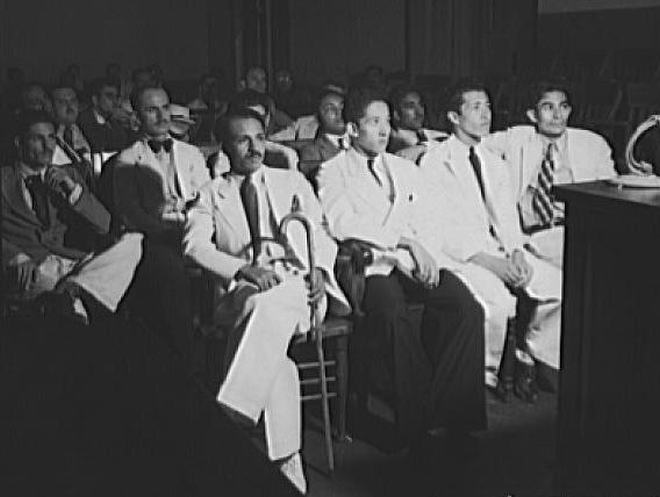
Defendants during the trial of the Nationalists at the former Spanish Army
barracks
in Ponce, Puerto Rico. (December, 1937). In the aftermath of the massacre,
no
police officer was convicted or sentenced to jail. No police were demoted or
suspended and Governor Winship never issued a public apology.

Reaction in the U.S. Congress
The Ponce Massacre reverberated through the U.S. Congress. On the House floor,
Congressman John T. Bernard expressed his shock and outrage. A record of his
speech is found in the Congressional Record. It says, "The police in Ponce,
probably with the encouragement of the North American police chief and even the
governor, opened fire on a Palm Sunday Nationalist march, killing seventeen and
wounding more than two hundred." Later, Congressman Vito Marcantonio also joined
in the criticism, filing charges against Governor Winship with President
Roosevelt.
Attempt on Winship's life.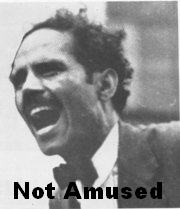
The year following the Ponce massacre, on 25 July 1938, Governor Winship wanted
to mark the anniversary of the US 1898 invasion of Puerto Rico with a military
parade. He chose the city of Ponce to demonstrate that his "Law and Order"
policy had been successful against the Nationalists. During the parade, shots
were fired at the grandstand where Winship and his officials were sitting in an
attempt to assassinate him. It was the first time that an attempt was made on a
governor's life in Puerto Rico. Winship escaped unscathed, but two men were
killed and 36 other people were wounded.
The dead included the Nationalist Angel Esteban Antongiorgi and National Guard
Colonel Luis Irizarry. The Nationalist Party denied participation in the attack,
but the government arrested several Nationalists and accused nine of "murder and
conspiracy to incite violence." Among the nine Nationalists charged and
convicted were Tomas Lopez de Victoria, captain of the Ponce branch of the
Cadets of the Republic, and fellow cadets Elifaz Escobar, Santiago Gonzalez
Castro, Juan Pietri and Prudencio Segarra. They served 8 years in the Puerto
Rico State Penitentiary. The four were pardoned by the next full-term
US-appointed governor, Rexford Guy Tugwell.
Winship tried to repress the Nationalists. Jaime Benitez, a student at the
University of Chicago at the time and later long-time chancellor of the
University of Puerto Rico, wrote to President Roosevelt stating, "Governor [Winship]
himself through his military approach to things has helped keep Puerto Rico in a
unnecessary state of turmoil. He seems to think that the political problem of
Puerto Rico limits itself to a fight between himself and the Nationalists, that
no holds are barred in that fight and that everybody else should keep out." Winship was replaced in 1939.
Removal of Winship as Governor
Marcantonio had continued to draw attention to Winship's egregious actions,
appealing to Roosevelt to replace him. In his speech before Congress titled
"Five Years of Tyranny", U.S. Congressman Vito Marcantonio reported how
"Ex-Governor Blanton Winship, of Puerto Rico, was summarily removed by the
President of the United States on May 12, 1939" after Marcantonio had filed
charges against Mr. Winship with the President. In his speech, Congressman
Marcantonio detailed the number of killings by the police and added, "the facts
show that the affair of March 21 in Ponce was a massacre...Governor Winship
tried to cover up this massacre by filing a mendacious report." He called
Governor Winship "the tyrant".
The Ponce Massacre Museum in Ponce
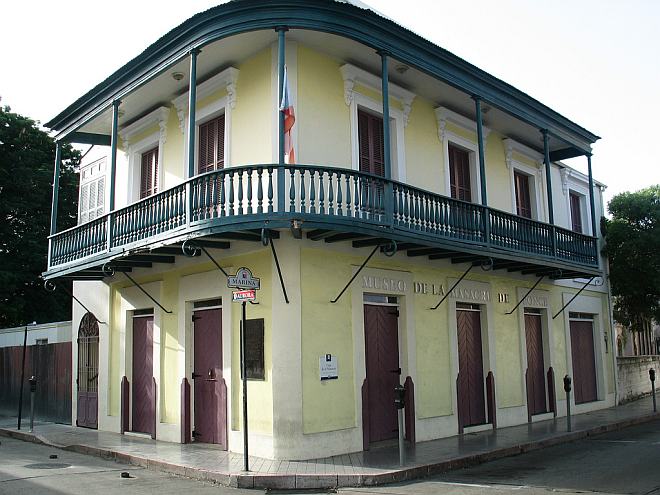
Today, the Ponce massacre is remembered and memorialized annually in honor of
the Puerto Ricans who perished or were wounded for their political beliefs. The
Institute of Puerto Rican Culture, an agency of the Government of Puerto Rico,
operates the Ponce Massacre Museum. It is located at the intersection where the
events took place (corner of Marina and Aurora streets). The museum houses
photographs and various artifacts from the Ponce massacre. A section of the
museum is dedicated to Dr. Pedro Albizu Campos.

CLICK this LINK for a 6 min VIDEO
WATCH
VIDEO HERE


donjibaro@gmail.com
This is the bottom line

“Live in such a way that no one blames the rest of us
nor finds fault with our work.” —(2 Corinthians 6:3)


Jibaros.Com®,
Jibaros.Net® - ALL content is Copyright © by Orlando Vázquez,
owner-designer and com does not accept any responsibility for the
privacy policy of third party sites